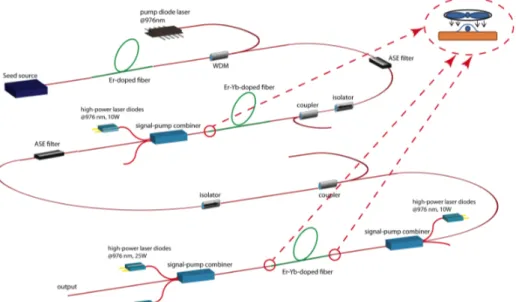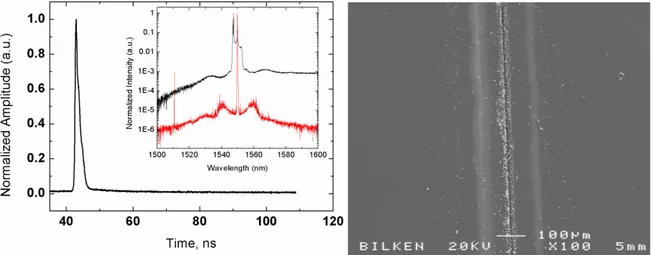CTu2M.5.pdf CLEO Technical Digest © OSA 2012
10 W, 10 ns, 50 kHz all-fiber laser at 1.55 µm
I. Pavlov1, E. Dülgergil2, E. Ilbey1, F. Ömer Ilday11Department of Physics, Bilkent Universty, TR-06800 Ankara, Turkey 2Meteksan Savunma Inc., Ankara, Turkey
Email: pavlov@fen.bilkent.edu.tr
Abstract: We report on an all-fiber, singlemode MOPA system at 1.55 µm producing 10-ns, 200-µJ pulses with 20
kW of peak power and utilize it to micromachine crystalline Si, which is largely transparent at this wavelength. OCIS code: (140.3510) Lasers, fiber; (060.2320) Fiber optics amplifiers and oscillators; (320.7090) Ultrafast lasers.
There is intense effort focussed on the development of fiber lasers due to their robust operation, low cost, high beam quality and high powers [1]. There are various applications, such as laser sensing, lidar applications, material processing, which require robust and high-power pulsed laser sources at 1550 nm with high beam quality. Achievement of high peak power is challenging due to well-known difficulties arising from strong nonlinear effects, including stimulated Raman scattering and, for narrow linewidth lasers, stimulated Brillouin scattering. The typical approach is to utilize large mode area fibers, which requires the use of specialty fibers or complex experimental setups. In Ref. [2], authors have shown MW-level peak powers, but the M2 value was 8.5. Recently, 200 µJ, 200 ns pulses were demonstrated at Hz-level repetition rates using a 17-µm core diameter gain fiber [3]. There are exciting results obtained with in-band pumping of Er-doped fibers [4,5].
Here, we report on the development of an all-fiber master-oscillator power-amplifier (MOPA) system, where the power amplifier is based on Er-Yb co-doped double-clad (DC) fiber. The system produces more than 10 W of average output power at 50 kHz repetition rate with 10 ns pulse duration, which corresponds to about 20 kW of peak power and 0.2 mJ of pulse energy. Despite the use of a quasi-single-mode gain fiber (core diameter of 12 µm), the amplifier output is obtained through a Corning SMF-28 fiber, which is strictly single-mode and absolutely no effort, even fiber coiling, is applied to the gain fiber to maintain the singlemode operation. This is the highest peak power, to our knowledge, of truly single-mode operation fiber amplifier at 1550 nm. One of the intended applications for this system is material processing, in particular silicon, which is nominally transparent at 1.55 µm. Thus, processing is expected to occur through nonlinear processes. We demonstrate the utility of the system, as well as verify its peak power, by micromachining Si at 1.55 µm. To the best of our knowledge, this is the first demonstration of Si micromachining at a wavelength where it is transparent.
Fig. 1. Schematic drawing of the experimental setup; MPC, multiple pump signal combiner; DCF, double-clad fiber, WDM, wavelength-division multiplexer. Inset: cooling system of the critical splice points.
The experimental setup is shown schematically in Fig. 1. Seed source was based on all-fiber Q-switch system with a repetition rate of 50 kHz and pulse duration of 15 ns. The output power of the seed signal is around 5 mW. It is amplified to 100 mW in a 1.2 m-long Er-fiber, which is core-pumped by a single-mode pump diode operating 976 nm. Experiment indicated that 100 mW average power with 2-µJ pulse energy is not enough to saturate power amplifier. Thus, a second preamplifier stage is introduced. Multimode pump diode with 976 nm central wavelength is used in this stage to pump 3.5 m-long DC Er-Yb-codoped fiber in the backward direction,
CTu2M.5.pdf CLEO Technical Digest © OSA 2012
increasing the average power to 300 mW. Finally, this signal is amplified in the last stage, which comprises of 6 m-long DC Er-Yb-codoped fiber (Coractive Inc.) with 12 µm core diameter, co-pumped into the cladding by three high-power multimode diodes at 976 nm through pump combiners [6]. The fibers comprising the signal-pump combiners are standard singlemode Corning SMF-28 fiber. Active cooling is typically needed for the gain fiber in high-power amplifiers, especially at the splice point for backward pumping, where pump and signal power are both at a maximum. In our case, we used a simple air cooling at the splice points (inset for Fig. 1).
The output spectra of the amplifier and the seed are shown in Fig. 2 (a). Due to the high peak power, strong nonlinear broadening of spectrum starts even after the second preamplifier. In order to control the spectral width, we use 6-nm bandpass filters after the first and second preamplifiers. Influence of the filters is clearly visible in the output spectrum. We are able to keep about 85% of the output power within a spectral range of 6 nm. Temporal profile of the amplified pulses are shown in the inset of Fig. 2 (a). The FWHM pulse duration is ~9 ns.
One of possible applications of this laser is material processing. For confirmation of the pulse quality, we modified surface of standard silicon wafer, which is one of most important materials in semiconductor industry. In particular, there is increasing demand for Si processing in photovoltaics, where the quality of processing and minimization of the heat affected zone is of great importance. This is typically done at wavelengths, where linear absorption is high. However, this has the unintended consequence of depositing energy to a wider area. Processing at a wavelength where Si is transparent would rely on nonlinear absorption, thus allowing increased localization of deposited energy. In this experiment, we focused laser beam on the surface by using a short focus lens. Incident average power was 4.3 W. Estimated peak intensity on the surface was around 19 GW/cm2. One of interesting features of this experiment is optical transparency of silicon at 1550 nm. Two-photon absorption is primarily responsible for creating plasma and ablation of the surface. Also, optical transparency of silicon allows processing the opposite side of the sample by simply adjusting the focal point. In our experiment, we were able to create plasma on both the front and back surfaces by shifting position of lens. SEM image of silicon wafer surface with a groove on the surface created by scanning the sample perpendicular to the beam direction is shown on the Fig. 2 (b). More detailed experiments are required for a full investigation for complete understanding.
Fig. 2. (a) Temporal profile of the 10-ns pulses. Inset: Log-scale optical spectrum of the seed (red line) and amplified (black line) pulses. (b) SEM image of micromachined cyrstalline silicon wafer, which is transparent at 1.55 µm.
In conclusion, we demonstrate an all-fiber and truly singlemode laser source producing 10 W, 10 ns, 50 kHz pulses at the eye-safe wavelength of 1.55 µm and we present preliminary results on material processing on Si, which is transparent at this wavelength. We expect this robust system to be of use in various applications requiring high pulse energy, low-repetition-rate pulses at an eye-safe wavelength.
[1] D. J. Richardson, J. Nilsson, and W. A. Clarkson, “High power fiber lasers: current status and future perspectives [Invited],” J. Opt. Soc. Am. B 27, B63-B92 (2010).
[2] S. Desmoulins and F. Di Teodoro, “High-gain Er-doped fiber amplifier generating eye-safe MW peak-power, mJ-energy pulses,” Opt. Express 16, 2431-2437 (2008).
[3] P. Wan, J. Liu, L.-M. Yang, and F. Amzajerdian, “Low repetition rate high energy 1.5 µm fiber laser,” Opt. Express 19, 18067-18071 (2011).
[4] For example, M. Dubinskii, V. Ter-Mikirtychev, J. Zhang and I. Kudryashov, “Yb-free, SLM EDFA: comparison of 980-, 1470- and 1530-nm excitation for the core- and clad-pumping,” Proc. SPIE 6952, 695205 (2008).
[5] J. C. Jasapara, M. J. Andrejco, A. D. Yablon, J. W. Nicholson, C. Headley, and D. DiGiovanni, “Picosecond pulse amplification in a core-pumped large-mode-area erbium fiber,” Opt. Lett. 32, 2429-2431 (2007).

